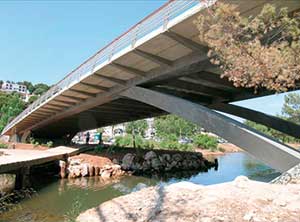Technical
AD 364: Welding stainless steel
This Advisory Desk Note provides guidance on welding stainless steel and gives references for further information. Stainless steel can be readily welded to itself, to carbon steel and to galvanized carbon steel. In order to ensure a sound welded joint, it is essential that the mechanical properties and corrosion resistance of the weld and parent material are suitably matched. Welding processes are chosen and weld procedures developed for the material and joint configuration to ensure that welds can be completed without flaws and that distortion is controlled. After welding, in order to achieve optimum corrosion performance, crevice features, contamination and at least all weld heat tints deeper in colour than a pale yellow should be removed by mechanical dressing followed by acid pickling of the joint.
Welding processes
The most common welding process for stainless steels is metal inert gas welding (generally referred to as MIG). Manual metal arc welding (MMA) and tungsten inert gas welding (TIG) require higher levels of skill and are generally slower, so they not preferred, except where high quality is a requirement. Laser welding is not an option for piecemeal fabrication but is used for factory production runs of specific products.
More detailed information on processes suitable for stainless steel is given at www.bssa.org.uk.
Welding stainless steel to stainless steel
The two most common families of stainless steel used in construction are austenitic and duplex stainless steels, both of which are ‘weldable’.
Austenitic stainless steel is readily welded to itself with or without filler wire. There are matching filler metals available for most of the austenitic range of alloys, for example grade 1.4301 (EN 10088 designation, the more common AWS designation is type 304) is generally welded with type 19 9 L filler metal (EN designation, as used in EN 1600, EN 12072 and EN 12073 – the more common AWS designation is 308L).
On the other hand, duplex stainless steel requires more control when being welded and may involve post weld heat treatment or special welding consumables. In general, for welding common grades of duplex such as grade 1.4462 (also known as grade 2205) to itself, the standard filler specified is 22 9 3 N L (2209 in AWS).
For welding austenitic steel to duplex stainless steel, fillers similar to those recommended below for welding duplex stainless steel to carbon steel should be used. It is noteworthy that austenitic stainless steels have lower strength than duplex grades and therefore welded joints made with austenitic filler metals will not be as strong as the duplex base metal.
Welding stainless steel to carbon steel
It is possible to weld stainless steel to carbon steel, provided that an appropriate filler is used. For welding austenitic stainless steels, the generally accepted procedure is to use an over-alloyed austenitic electrode to ensure adequate mechanical properties and corrosion resistance. Although a standard 19 9 L filler (AWS 308L) can be used for joining austenitic steel to carbon steel, more highly alloyed fillers, such as the 23 12 L (309L) are preferable.
Similar fillers are recommended for welding duplex stainless steels to carbon steel as for welding duplex to duplex. Hence, as discussed earlier, for duplex grades such as 1.4462 (2205), the standard filler specified is 22 9 3 N L (2209 in AWS). The higher nickel content ensures the correct 50/50 ferrite/austenite structure in the weld deposit, thus maintaining strength, ductility and corrosion resistance. Austenitic fillers such as 23 12 2 L (309LMo in AWS), which are low in carbon and have a molybdenum content intermediate between the two steels, can also be used.
Welding stainless steel to galvanized steel
When welding stainless steel to galvanized steel, the zinc coating around the area to be joined must be removed before welding. The inclusion of zinc can result in embrittlement or reduced corrosion resistance of the finished weld and, in addition, the fumes given off when attempting to weld through the galvanized layer are a significant health hazard. Once the galvanizing has been removed, welding requirements are as for ordinary carbon steel.
Risk of bimetallic corrosion between carbon and stainless steel
Bimetallic corrosion between carbon and stainless steel is rarely a problem in building environments. However, unprotected welds between them subject to aggressive environments such as immersion in seawater could result in accelerated corrosion of the less noble carbon steel. In this instance, it is preferable to extend the coating on the carbon steel onto the stainless steel to a distance of about 50mm from the weld.
Further information
Further information is available from www.bssa.org.uk.
Design Manual for Structural Stainless Steel (Third Edition, 2006), Euro Inox and SCI.
Available from www.euro-inox.org and www.steel-stainless.org/designmanual
The Online Information Centre for Stainless Steel in Construction: www.stainlessconstruction.com
EN 1011-3:2000 also provides technical re-commendations for arc welding of stainless steel.
Contact: Katherine A Cashell
Tel: 01344 636525
Email: advisory@steel-sci.com











